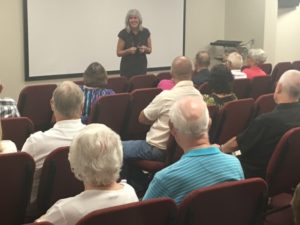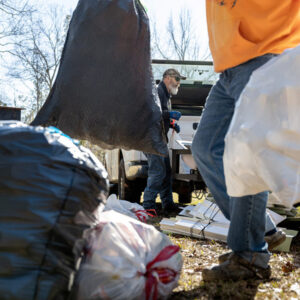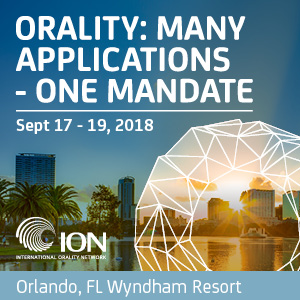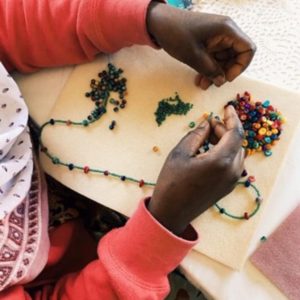Learning that Transforms Lives
 On my first day of school as a newly minted high school English teacher, I faced two classes of low-level seniors. They stared back at me, 23 years old, barely older than they. One student bragged, “We got rid of a teacher and two subs last year. How long do you plan to stay?” I smiled back undaunted, knowing that I would have to create a compelling experience or lose them on the second day.
On my first day of school as a newly minted high school English teacher, I faced two classes of low-level seniors. They stared back at me, 23 years old, barely older than they. One student bragged, “We got rid of a teacher and two subs last year. How long do you plan to stay?” I smiled back undaunted, knowing that I would have to create a compelling experience or lose them on the second day.
On the second day, I opened the box of basic skills books. I picked up a book, and ripping off the cover and several pages, I dropped the book into the trash. I offered each student a book to tear up and throw away. Finally, I had their attention. Then, I asked, “What do you want to do this year?”
One student offered, “We want to go on a field trip. The smart kids always get to go on fieldtrips.” He nodded and smiled smugly at the other students.
A girl offered, “Read Shakespeare like the smart kids.” A few students yelled, “Yeah,” while others groaned.
A long-haired boy smirked, “Get us jobs.”
I strapped on those simple requests like a parachute, trusting that their fulfillment would save me. Even though I broke up fights and confronted a drunk student that year, I plowed forward with the students who wanted to learn. That year, we read Hamlet by Shakespeare; we told our stories; we held mock interviews with community members; and we went to an automotive plant field trip. As the year drew to a close, I observed something important. The students had been engaged in learning most of the time, and in sacred moments, we had shared real conversations about faith and life.
In May, my husband and I moved to a new city for graduate school, and I took a job with the local school system in an alternative school. My students faced challenges like pregnancy and drug abuse. Believing that every child can learn, I searched for ways to engage and motivate them.
In the decades that followed, I homeschooled my children and taught middle and high school language arts in a private school. During the early years, I could not have articulated what I was discovering about student engagement in learning, but I knew instinctively that student-centered practices held the key.
While pursuing my master’s degree in Educational Leadership, the Dean of Education challenged a lecture hall filled with future school leaders: Learn the difference between educating and schooling. Further, he emphasized that the outcome of our efforts would result in either simply transmitting information to our students to pass a class or transforming our students into learners, changed and equipped for life.
Through the years, I had collected the pieces of a puzzle, but now, I understood how they fit together. For me, bored stares were the death knell of teaching. In my classroom, I had pressed toward authentic conversations and active participation, but I hadn’t understood what created that environment and why the end goal of education must be transformation. As educators, we should continually search for the answer to this question: What kind of learning transforms and engages students?
Orality and Learning
We engage students when we help them to receive new information through a variety of modalities. Most learners receive information in either auditory, visual, or kinesthetic modes. While individuals may prefer one or two of these ways, we are all a blend of learning styles.
Since we learn in a variety of ways, educators should address the various learning styles. Auditory or oral strategies are often preferred by educators in the form of lecture and what I call “teacher talk.” But, oral strategies should include “student talk.” Brain research has taught us that the person who talks, defines, and processes information grows dendrites in his brain, firing synapses. Shouldn’t that person be the student instead of the teacher? Oral strategies should also include discussions, debates, and opportunities to provide oral feedback.
As a classroom teacher, I engaged students in learning for 5-10 minutes, and then, I asked them to turn and talk to their partners. Once students processed the information, I asked questions by calling on them. The part of me that is an auditory or oral learner, longs to talk about what I’m learning shortly after learning it. Additionally, auditory or oral learners should be given opportunities for assessment in their preferred style, by verbalizing their understanding through speeches, recordings, debates, or songs. Brain Rules author, Dr. John Medina, a molecular biologist, reinforces the need to tell a relevant story, show a relevant video, or do a relevant activity every 10 minutes during a presentation of information.
Stories and Learning
Simply engaging students in learning through differentiating learning styles isn’t enough to produce transformation. In fact, communicating information to students and expecting them to restate it on an assessment simply reinforces the transmission of facts and ideas. For transformation to take place, students must be engaged in learning. Engagement is cemented in emotion. In other words, emotional engagement grows out of a compelling and relevant understanding about a topic or idea.
To that end, compelling stories engage our emotions. By tapping into the emotions of learners, stories help us to construct meaning, and remember what was learned. In education, the more that we can relate a meaningful story to learning, the more likely students are to remember the process and outcome. Likewise, if we can guide students in connecting what they have learned to their own experiences and stories, they are more likely to understand what was taught and remember it longer. For instance, when a teacher guides students to recall a situation in their own lives and the emotion that situation evoked, she has prepared her learners to connect the new learning to the old situation.
Ultimately, when a student can construct meaning from ideas and concepts and then transfer their learning effectively to new situations (Wiggins, G, & McTighe, J., 2011), transformational education has taken place.
Orality in Education Converges with the Gospel
My passion for connecting students to learning in meaningful ways and my passion for taking the story of Jesus to the nations converged in 2015 when I read No Greater Joy by Jerry Wiles. A few months later, I attended an orality training class led by the author. Through orality training, I learned how to take stories of Jesus to oral learners. The principles of teaching the stories align with sound oral instruction, and the true stories engage hearers as they learn about Jesus.
While in India with a team from my church, I shared the story of the blind beggar with a group who lives in an isolated village. After sharing the story, I asked if someone in the crowd would share the story. A nine-year-old girl raised her hand, and standing, she repeated the story. Transfer learning had taken place on that small, sweltering porch in India.
Orality training exemplifies oral methods in teaching the stories of Jesus to oral learners. My favorite learning strategy from Jerry Wile’s book captures the simplicity of storytelling.
“Learn a little.
Practice a lot.
Implement immediately.
Tell the stories often.”
Conclusion
As educators, whether in the classroom or church, we cannot afford to waste time on learning strategies that do not bring about transformation. Where a lost world is concerned, too much is at stake. Orality provides an opportunity to engage learners. When the learners hear the stories about Jesus, the most important transformation takes place, a transformation from death to life, and the most important transfer learning takes place, the gospel spreads.
« Oralities & Literacies – Chapter 6 &#...A Mom With A Mission »










